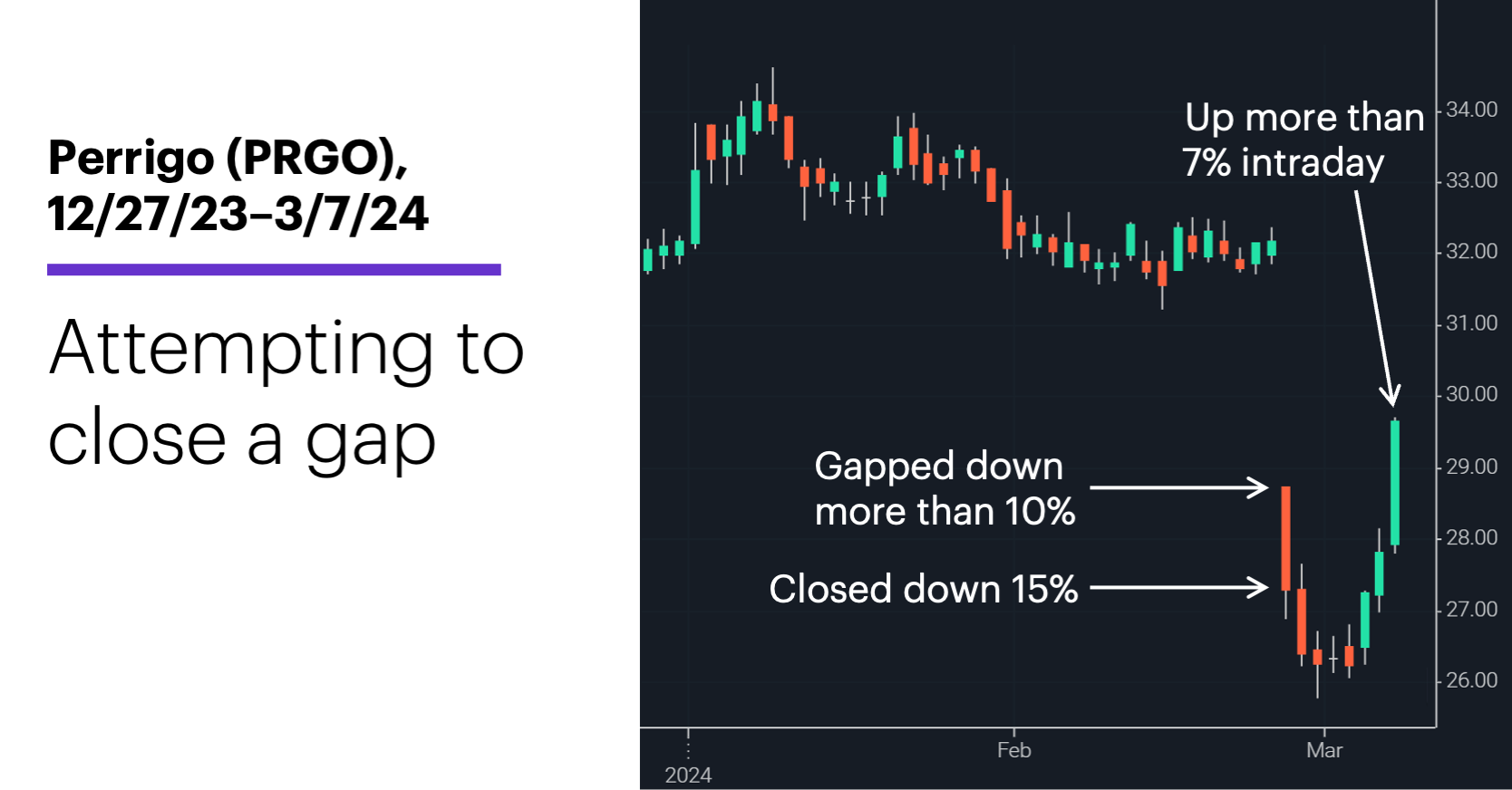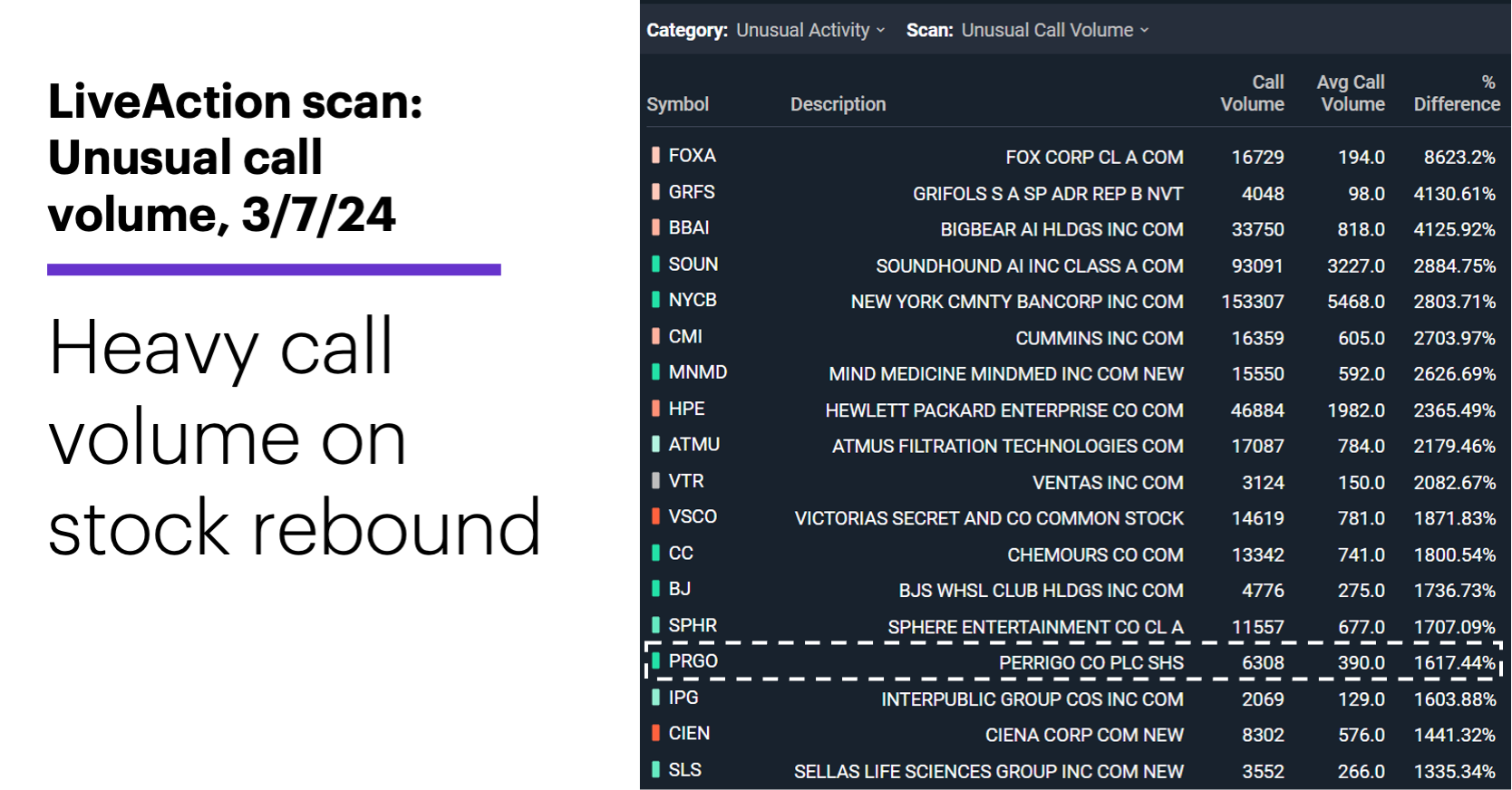Minding the price gap
- PRGO gapped down more than 10% on Feb. 27
- Stock was up more than 7% intraday on Thursday
- Call options volume was more than 16 times average
Gaps, as the old saying goes, are meant to be filled. But like many bits of market wisdom, this one doesn’t necessarily hold up well to scrutiny.
The issue is whether prices, after gapping above the previous day’s high or below the previous day’s low, tend to reverse enough to fill that empty space on the price chart. The underlying logic is that gaps are often overreactions to surprise information, and that a potential counterreaction can represent a short-term trade opportunity.
Take a look at the move that occurred in Perrigo (PRGO) on February 27 after the company issued disappointing guidance.1 After gapping down more than 10% on the open, the stock ended the day with a 15% loss:

Source: Power E*TRADE (For illustration purposes. Not a recommendation.)
The nature of the price action since then is, like beauty, in the eye of the beholder. At Thursday’s high, PRGO was more than 7% intraday, part of a three-day, 14% upswing that would seem to support the case of contrarians inclined to trade on the assumption that gaps are soon filled.
Also, traders were more active than usual in PRGO calls on Thursday, with call volume more than 16 times average in early trading:

Source: Power E*TRADE (For illustration purposes. Not a recommendation.)
But those bullish bullet points overlook the fact that the stock fell an additional 4.5% in the days after February 27 before turning higher. Also, despite Thursday’s big rally, PRGO still hadn’t filled half of the down gap.
While that’s far from an insurmountable task, it raises an important point about gaps. Traders inclined to think gaps are meant to be filled are typically thinking on a shorter-term time horizon. In other words, does it really count if a gap is “filled” two years later? Most traders would likely answer in the negative.
In this case, PRGO’s track record of filling its down gaps is mixed, at best. Since 1991, the stock has had 54 down gaps of at least 1%. It closed the gap within 20 trading days (roughly one month) in 28 of those cases, or 53% of the time.
If that doesn’t seem to back the idea that gaps are “meant” to be filled, the odds were even lower for bigger gaps. There were only 15 down gaps of 5% or more, and the stock filled only one of those within 20 trading days. None of the five down gaps that exceeded 9% were filled within 20 trading days.
But there’s a caveat to this caveat. Just because the stock didn’t close many of its gaps in a timely manner doesn’t mean there wasn’t some evidence of a counterreaction. For example, five trading days after all down gaps of 1% or more, PRGO was higher in 31 of 53 cases, with an average gain of 1.1%.2
No move is ever guaranteed, but experienced traders know that inherited “wisdom” often clashes with the reality of the markets.
Today’s numbers include (all times ET): Employment Report (8:30 a.m.).
Today’s earnings include: Buckle (BKE), Janux Therapeutics (JANX).
Click here to log on to your account or learn more about E*TRADE's trading platforms, or follow the Company on Twitter, @ETRADE, for useful trading and investing insights.
1 StreetInsider. Perrigo (PRGO) Tops Q4 EPS by 3c; Offers Guidance. 2/27/24.
2 All figures reflect Perrigo (PRGO) daily price data, 1991-2024. “Down gaps” are defined here as the percentage difference between the current day’s high and the previous day’s low, when the current day’s high is the lower of the two. “PRGO was higher in 31 of 53 cases” means its price was above the closing price of the down-gap day. Supporting document available upon request.